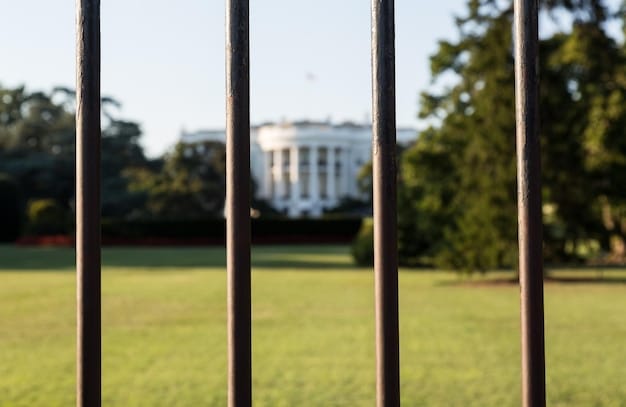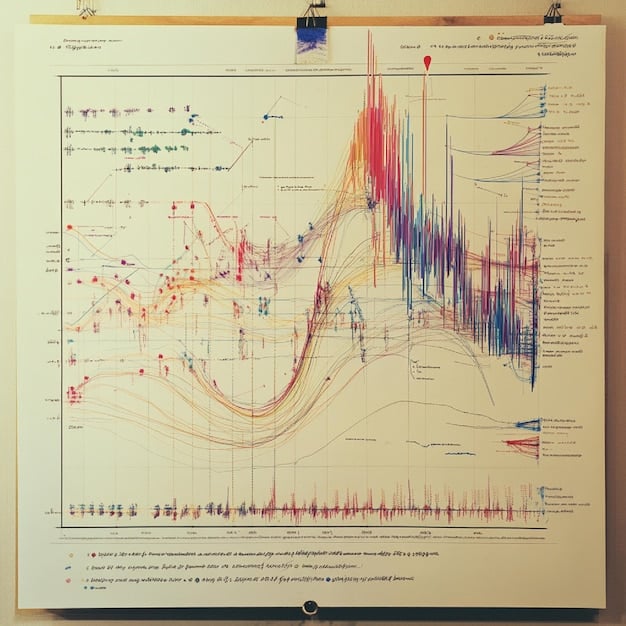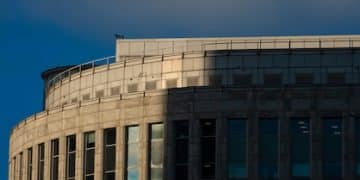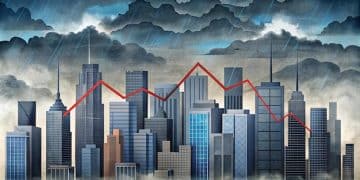Will the Fed Raise Interest Rates Again in Early 2025? Expert Analysis

Will the Fed Raise Interest Rates Again in Early 2025? Experts Weigh In: The likelihood of the Federal Reserve raising interest rates again in early 2025 remains uncertain, with economists suggesting that it will depend on inflation trends and economic growth data observed in the coming months.
The question on every investor’s mind: Will the Fed Raise Interest Rates Again in Early 2025? Experts Weigh In. Uncertainty shrouds the economic landscape, making predictions a complex endeavor.
Understanding the Fed’s Current Stance
To anticipate Will the Fed Raise Interest Rates Again in Early 2025? Experts Weigh In, it’s crucial to first understand their current position. Recent statements and policy decisions offer clues about their future intentions.
The Federal Reserve has been navigating a delicate balance between controlling inflation and supporting economic growth. Let’s delve into the factors influencing their decisions.
Recent Interest Rate Hikes
The Fed has implemented several interest rate hikes over the past year. These hikes were aimed at curbing inflation, which had reached levels not seen in decades.
Impact on the Economy
These rate hikes have had a noticeable impact on various sectors of the economy. Housing, in particular, has seen a slowdown in activity as mortgage rates have increased.
- Slowing Inflation: Interest rate hikes are designed to cool down the economy and bring inflation under control.
- Impact on Borrowing: Higher rates increase the cost of borrowing for businesses and consumers.
- Recession Risks: Aggressive rate hikes can increase the risk of triggering a recession.
Ultimately, the Fed’s decisions are driven by a complex interplay of economic indicators. Understanding these indicators is key to predicting future rate hikes.

Inflation: The Key Driver
One of the most critical factors influencing Will the Fed Raise Interest Rates Again in Early 2025? Experts Weigh In will be the trajectory of inflation. If inflation remains stubbornly high, the Fed may feel compelled to raise rates further.
Inflation data will be closely scrutinized by economists and policymakers alike. Key metrics include the Consumer Price Index (CPI) and the Personal Consumption Expenditures (PCE) price index.
Current Inflation Trends
While inflation has shown signs of cooling in recent months, it remains above the Fed’s target of 2%. The pace of decline will be crucial.
Factors Influencing Inflation
Supply chain issues, labor market tightness, and geopolitical tensions are all contributing factors to inflation. Resolving these issues could help ease inflationary pressures.
- Wage Growth: Rapid wage growth can contribute to inflation as businesses pass on higher labor costs to consumers.
- Supply Chain Disruptions: Ongoing disruptions can lead to shortages and higher prices for goods.
- Energy Prices: Fluctuations in oil and gas prices can have a significant impact on overall inflation.
In conclusion, persistent high inflation will likely prompt the Federal Reserve to consider further interest rate hikes in their attempt to stabilize prices.
Economic Growth: A Balancing Act
The Fed must also consider the impact of its policies on economic growth. Raising interest rates too aggressively could stifle growth and potentially trigger a recession, influencing Will the Fed Raise Interest Rates Again in Early 2025? Experts Weigh In.
The Fed’s dual mandate is to promote both price stability and full employment. Balancing these two goals can be challenging.
GDP Growth
Gross Domestic Product (GDP) is a key indicator of economic growth. A slowdown in GDP growth could make the Fed hesitant to raise rates further.
Labor Market Conditions
The labor market remains relatively strong, with low unemployment rates. However, cracks may begin to appear if economic growth slows.
- Job Creation: Consistent job creation is a sign of a healthy economy.
- Unemployment Rate: A low unemployment rate indicates a tight labor market.
- Wage Pressures: Strong wage growth can be a double-edged sword, contributing to both economic growth and inflation.
In summary, the Federal Reserve faces the intricate task of supporting economic growth while simultaneously keeping inflation in check. Economic indicators will significantly guide their decisions.
Expert Opinions and Forecasts
Economists and market analysts have varying opinions on Will the Fed Raise Interest Rates Again in Early 2025? Experts Weigh In. Their forecasts are based on complex models and assessments of the economic outlook.
Some experts believe that the Fed is likely to pause rate hikes, while others anticipate further increases. It’s essential to consider a range of perspectives.
Divergent Views Among Economists
Some economists argue that inflation is already under control and that further rate hikes are unnecessary. They point to signs of slowing economic growth as evidence.
Market Expectations
Financial markets are constantly adjusting to new data and expectations about future Fed policy. Market sentiment can be a valuable indicator.
- Interest Rate Futures: These contracts reflect market expectations for future interest rates.
- Bond Yields: Changes in bond yields can signal shifts in investor sentiment.
- Stock Market Performance: The stock market can react sharply to news about Fed policy.
In conclusion, expert opinions on future rate hikes remain divided. Market expectations and data play a part in predicting the Fed’s actions.

Geopolitical Factors and Global Economy
Geopolitical events and the state of the global economy can also influence the Fed’s decisions regarding Will the Fed Raise Interest Rates Again in Early 2025? Experts Weigh In. Disruptions in global trade, political instability, and economic slowdowns in other countries can all impact the U.S. economy.
The Federal Reserve considers global factors when making monetary policy decisions. The U.S. economy is increasingly interconnected with the rest of the world.
Impact of Global Events
Events such as wars, political crises, and trade disputes can create uncertainty and volatility in financial markets.
Global Economic Slowdown
A slowdown in global economic growth can reduce demand for U.S. exports and weigh on the U.S. economy.
- Trade Policies: Changes in trade policies, such as tariffs, can disrupt supply chains and impact prices.
- Currency Fluctuations: Fluctuations in exchange rates can affect the competitiveness of U.S. exports.
- International Cooperation: Cooperation among central banks can help stabilize the global economy.
To sum up, the Fed must consider the global landscape, as international events and economic trends can significantly influence U.S. monetary policy decisions.
Alternative Scenarios: A Data-Driven Approach
To effectively forecast Will the Fed Raise Interest Rates Again in Early 2025? Experts Weigh In, it’s helpful to consider a few different scenarios; each depends on how key economic data points evolve.
By examining these potential outcomes, you can better understand the range of possibilities and their influence on the future of interest rates.
Scenario 1: Stable Inflation and Moderate Growth
In this scenario, inflation gradually declines towards the Fed’s 2% target, and economic growth remains moderate. The labor market remains healthy without excessive wage pressures.
Scenario 2: Persistent High Inflation and Slow Growth
If inflation remains stubbornly high and economic growth stagnates, the Fed might face a difficult choice between fighting inflation and supporting the economy.
- Stagflation Risks: A combination of high inflation and slow growth is often referred to as stagflation, which can be particularly challenging for policymakers.
- Policy Trade-offs: The Fed may need to prioritize one goal over the other, depending on the severity of the situation.
- Uncertainty and Volatility: This scenario could lead to increased uncertainty and volatility in financial markets.
Therefore, analyzing multiple scenarios is valuable in economic forecasting. As the future path of interest rates comes into view, remain flexible and data-driven.
| Key Topic | Brief Description |
|---|---|
| 📈 Inflation Trends | Monitoring CPI and PCE for signs of cooling or persistence. |
| 💼 Economic Growth | Balancing rate hikes with GDP and labor market health. |
| 🌍 Global Factors | Geopolitical events and global economic impact on US rates. |
FAQ
▼
The Federal Reserve will primarily consider inflation data, economic growth indicators, and labor market conditions. They aim to balance price stability with full employment.
▼
Geopolitical events can create economic uncertainty, disrupt supply chains, and affect financial markets, influencing the Fed to adjust monetary policy accordingly.
▼
The Federal Reserve’s target inflation rate is 2%. This target is a key benchmark for guiding decisions on interest rate adjustments.
▼
Interest rate futures are contracts reflecting market expectations for future interest rates. They can indicate the likelihood of upcoming rate adjustments by the Fed.
▼
A strong labor market can lead to wage growth, potentially driving inflation. The Fed monitors this closely as it decides whether to adjust interest rates.
Conclusion
Predicting whether the Federal Reserve will raise interest rates again in early 2025 is a complex undertaking. It depends on a multitude of factors, primarily inflation, economic growth, and global events. Keeping a close eye on these key indicators will be crucial for investors and policymakers alike.





